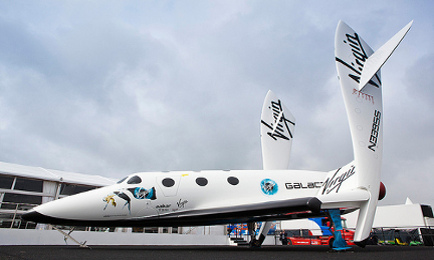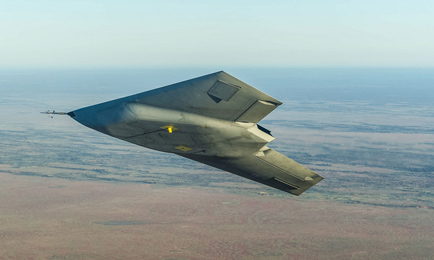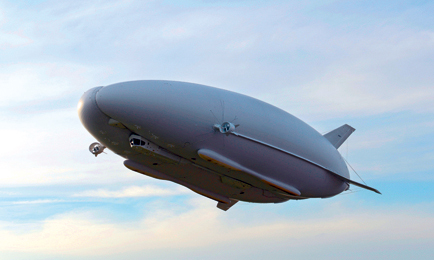This week Virgin Galactic confirmed it would start testing another space plane by the end of this year. The first space plane crashed during flight tests last October, tragically killing the pilot.
Virgin Galactic’s troubles is a reminder of not just the perils of aerospace development, but also the global industry’s indomitable striving for innovation. Aerospace engineers across the world are constantly developing aircraft to travel faster, safer, more comfortably and more economically. They are even pushing the technological boundaries up into space.
Unmanned aircraft are set to reshape how we transport and deliver goods. Some companies are returning to old ideas with fresh technology - developing giant airships to transport cargo, or personal jetpacks for emergency services. Meanwhile, defence programmes continue to fund some of the most ground-breaking aerospace technologies.
Below are ten of the most interesting and exciting aircraft development programmes we’ve come across. They are international scope and ambition, in development now and target being in the air within the next 15 years.
-
Skylon
A reusable, unpiloted spaceplane being developed by Reaction Engines, the aircraft will be capable of transporting up to 15 tonnes of cargo into space. It will operate from a runway, be 82m long with a wingspan of 25m and constructed from carbon-fibre reinforced plastic.
The real role of Skylon will be to demonstrate Reaction Engines’ Sabre (Synergetic Air-Breathing Rocket Engine). Sabre is the key technological goal for Reaction Engines, a hybrid air-breathing jet engine and conventional rocket in one unit. The engine will use oxygen from the atmosphere to burn with liquid oxygen fuel and switch to conventional rocket mode when out of the atmosphere. The use of air as the oxidiser reduces the amount of fuel the aircraft has to carry, enabling it to travel into orbit.
A demonstrator for the Sabre engine has been produced and fired in a testbed. This video by Alan Bond, chief engineer and founder of Reaction Engines, provides detailed insight into how Sabre will work. A prototype for Skylon is expected to be completed by 2017, with flight tests to start in 2020.
-
Spaceshiptwo

This suborbital spaceplane takes a different approach to Skylon and really compromises two vehicles. The White Knight Two cargo plane mothership carries the Spaceshiptwo spacecraft to 50,000ft, whereupon it is released and uses its rocket engines to fly into the upper atmosphere. Spaceshiptwo would then land on a conventional runway.
Developed by US company Scaled Composites, the previous iterations of the aircraft achieved the first manned private spaceflight in 2004. Scaled Composites is supplying the latest version to Richard Branson's Virgin Galactic, which has ordered five Spaceshiptwos and two White Knight Twos.
More than 700 people have already booked places on Virgin Galactic's first spaceflights. The company looked the closest to making the dream of private spaceflight possible until the crash during a flight test last October. The test pilot was killed, but the company is continuing to manufacture the spacecraft, with commercial service planned for 2016.
The low-aspect ratio spaceplane will carry eight passengers at a time and will be propelled by a single hybrid rocket engine, the development of which has proved problematic.
-
Boeing's F/A-XX - sixth generation fighter

The US has two programmes to develop new fighter aircraft for the 2030s: the “Next generation Air Dominance” programme, also known as the F/A-XX, is a development programme to replace the US Navy's F/A 18 Super Hornet. The F/A-X programme is looking at the replacement for the F22 and F35 aircraft that are currently in service. The Defence Advanced Research Projects Agency-led (DARPA) studies have engaged Boeing and Lockheed Martin in early studies, and both companies have released details about the design and technology that could be used in the next generation of fighter jets.
A Boeing concept plane shows a tail-less twin-engine stealth fighter with supersonic inlets like those on the Lockheed Martin F-35 Joint Strike feature. The aircraft would be available in manned and unmanned versions and also features canards.
The Lockheed design shows a nose similar to the F-22's, a highly contoured wing and almost flat tails. The aircraft could feature technology such as self-healing structures and multi-spectral health. New breakthroughs in propulsion, materials, power and weaponry are needed before the plane can be made a reality, the company has said.
Acquisition for the US military’s sixth generation of fighter aircraft is planned to start in 2018 after further studies.
-
SR-72 Blackbird hypersonic spy jet

Staying with the US military, Lockheed Martin has confirmed it is actively developing a successor to the Blackbird SR-71 cold war spy plane by 2030.
The Blackbird SR-72 will be an unmanned aircraft, capable of hypersonic speeds of 4,500 mph, almost double the speed of its predecessor. This will enable the aircraft to either strike or surveil any location in the world in just over one hour.
The aircraft will use a combined cycle to achieve these speeds - an integrated turbine engine and a supersonic combustion ramjet air breathing jet engine, or scramjet, says Lockheed. The company is working with Aerojet Rocketdyne to develop the engine.
The US military and Lockheed Martin have been investigating scramjets for several years, and like others looking at the technology, are making slow progress. However, Lockheed has said the SR-72 programme will use lessons learned from previous efforts, such as the Falcon Hypersonic Technology Vehicle.
-
Aerion AS2 supersonic business jet

Aerion is one of several firms developing supersonic business jets. Arguably, Aerion has the strongest pedigree and is the likeliest to achieve its aim of a first flight for its AS2 aircraft by 2019 and commercial service by 2023.
The company’s approach to supersonic flight can be traced back to US defence research into supersonic natural laminar flow (SNLF) from the 1990s. Aerion says its wing design halves friction drag over the wing compared with conventional swept or delta wings, increasing power, lowering weight and improving fuel efficiency, thereby making supersonic flight commercially viable.
Last year, flight tests conducted with Nasa demonstrated the viability of its wing design and Airbus announced a partnership with the company to help it develop and certify its first aircraft, the AS2.
The AS2 is an update of a 10-year-old twinjet business jet design. It features three engines and a very thin, unswept wing, tapered with a sharp leading edge and a slightly curved airfoil. The aircraft will cruise at Mach 1.6, and have a take-off weight of 52,200kg and a range of 8,800km.
It remains to be seen if a market exists for supersonic business jets after Concorde was famously retired in 2003. Aerion predicts that the market will be between 400 and 600 aircraft over the next 15 to 20 years.
-
Martin Jetpack

“Dude, where’s my jetpack?” has been a popular refrain of the frustrated internet tech geek, for many years but next time you hear it, you can reply, “New Zealand”.
The Martin Aircraft Company is based in Christchurch and its jetpack has been in development for more than 30 years. Next year the company will start selling it for £130,000 to the emergency response and defence markets.
The jetpack uses twin ducted fans to produce lift which are driven by a 200hp two stroke, two litre fuel injected engine fuelled by petrol. It has a top speed of 74km/h and can hover at an altitude of up to 1,000m. It has a 30 minute or 30 mile range.
It features flight and engine displays, a harness, ballistic parachute and energy absorbing undercarriage that can crumble on impact.
The company is also developing an unmanned version, called the Skyhook, which will take advantage of the aircraft's heavy payload capability.
-
Taranis

Taranis is an unmanned combat air vehicle (UCAV) being developed by BAE Systems and Rolls-Royce to demonstrate the future technologies and capabilities in aerial drone warfare. BAE Systems describes it as “the most advanced aircraft ever produced in the UK”.
The UCAV is about the same size as the Royal Air Force’s Hawk trainer jet, and has distinctive swept back wings and a wedge shape. It is fitted with a Rolls-Royce Adour 951 engine, which has to be fully embedded into the airframe, for reduced radar cross-section and to lower the chances of infrared detection.
Taranis is designed to carry out sustained surveillance and carry out strikes over a long range whilst remaining undetected. The aircraft was flown in its “stealth” configuration for the first time last year and flight tests are continuing.
Ultimately, the plan is to combine knowledge on unmanned combat air vehicles with French military, to inform the design of future unmanned combat platforms. This work could see the UK and France jointly develop an unmanned combat air vehicle in the future.
-
Airlander HAV airship

The world’s largest aircraft is a 91m long, 34m wide, 26m high airship / plane / helicopter hybrid that was initially developed for the US military for surveillance, communications and delivering aid.
The project was cancelled in 2013, but the company behind the airship, Hybrid Air Vehicles, bought it back from the military and intend to commercialise it for transporting cargo and luxury travel.
The dimensions of the aircraft are in its fully-inflated state, with the hull being filled with inert helium. The skin of the aircraft is made from a composite of Kevlar, Mylar, and Vectran, which Hybrid Air Vehicles claims can withstand small arms fire. It has four propellers, two at the back, and one each at the front left and front right, powered by four diesel-powered turbocharged V8 engines. Max airspeed is about 92 mph, with a payload capacity of 10,000 kg.
The Airlander 10 will lead to the development of the Airlander 50 by 2019. a larger hybrid airship which will be able to transport up to 50 tonnes of freight.
-
PAK TA - Russian military troop and vehicle carrier

Staying with large aircraft, details about this supersonic cargo plane being developed in Russia are hazy and subject to the internet rumour mill. But the bold ambition of the PAK-TA, as reported by state-backed news outlet RT, cannot be faulted.
According to RT, the PAK-TA is being developed by the Ilyushin Aviation Complex, Moscow, with 80 planes planned to enter service in 2024. The design specification for the transport aircraft, which will transport troops, armoured vehicles and heavy weaponry to combat zones, will fly at speeds of up to 2,000km\h, have a payload of 200 tons and a minimum range of 7,000km.
The objective, according to RT’s source (which comes via another online news outlet) is to be able to airlift an army to any place in the world in a matter of hours. A frightening prospect, but is it even remotely realistic? The initial PAK-TA specification was known to be less ambitious, freighters with a 900km/h cruising speed and a 4,500km range.
-
Airbus Electric E-Fan

A quiet development program in terms of both the noise the aircraft actually makes and the marketing, Airbus’ E-Fan 2.0 aims to be the first certified electric aircraft on the market with series production planned to start in 2017.
The plane is a two-seat general aviation trainer made from composites. It is powered by a series of 250V batteries and two 30kW electric motors that spin two ducted, variable pitch fans mounted on the sides of the rear fuselage. The E-Fan 2.0 has enough power for one hour of flight and takes one hour to recharge. It also has a backup battery to enable emergency landings.
A hybrid-electric four-seater version is planned that will increase the maximum flight time from nearly an hour to 3.5 hours.
The aircraft was first demonstrated at the Farnborough Airshow in 2014, but what really excites aviation enthusiasts is that Airbus has said that the the E-Fan is the first step towards an electric commercial aircraft.
If you disagree, or think we are missing a leading project, please let us know in the comments section below.